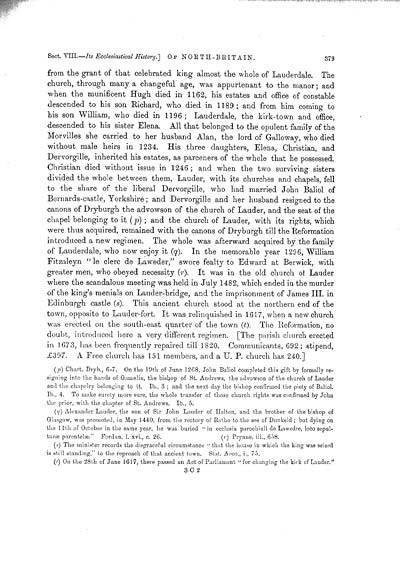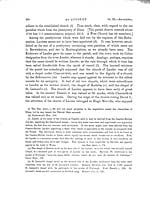Volume 3
(391) Page 379
Download files
Individual page:
Thumbnail gallery: Grid view | List view

379 from the grant of that celebrated king almost the whole of Lauderdale. The church, through many a changeful age, was appurtenant to the manor ; and when the munificent Hugh died in 1162, his estates and office of constable descended to his son Richard, who died in 1189 ; and from him coming to his son William, who died in 1196 ; Lauderdale, the kirk-town and office, descended to his sister Elena. All that belonged to the opulent family of the Morvilles she carried to her husband Alan, the lord of Galloway, who died without male heirs in 1234. His three daughters, Elena, Christian, and Dervorgille, inherited his estates, as parceners of the whole that he possessed. Christian died without issue in 1246; and when the two surviving sisters divided the whole between them, Lauder, with its churches and chapels, fell to the share of the liberal Dervorgille, who had married John Baliol of Bernards-castle, Yorkshire; and Dervorgille and her husband resigned to the canons of Dryburgh the advowson of the church of Lauder, and the seat of the chapel belonging to it (p) ; and the church of Lauder, with its rights, which were thus acquired, remained with the canons of Dryburgh till the "Reformation introduced a new regimen. The whole was afterward acquired by the family of Lauderdale, who now enjoy it (q). In the memorable year 1296, William Fitzaleyn " le clerc de Laweder," swore fealty to Edward at Berwick, with greater men, who obeyed necessity (r). It was in the old church of Lauder where the scandalous meeting was held in July 1482, which ended in the murder of the king's menials on Lauder-bridge, and the imprisonment of James III. in Edinburgh castle (s). This ancient church stood at the northern end of the town, opposite to Lauder-fort. It was relinquished in 1617, when a new church was erected on the south-east quarter of the town (t). The Reformation, no doubt, introduced here a very different regimen. [The parish church erected in 1673, has been frequently repaired till 1820. Communicants, 692; stipend, �397. A Free church has 151 members, and a U. P. church has 240.] (p) Chart. Dryb., 6-7. On the 19th of June 1268, John Baliol completed this gift by formally re- signing into the hands of Gamelin, the bisbop of St. Andrews, the advowson of the church of Lauder and the chapelry belonging to it. Ib., 3 ; and the next day the bishop confirmed the piety of Baliol. Ib., 4. To make surety more sure, the whole transfer of those church rights was confirmed by John the prior, with the chapter of St. Andrews. Ib., 5. (q) Alexander Lauder, the son of Sir John Lauder of Halton, and the brother of the bishop of Glasgow, was promoted, in May 1440, from the rectory of Ratho to the see of Dunkeld; but dying on the 11th of October in the same year, he was buried " in ecclesia parochiali de Lawedre, loco sepul- turse parentelae." Fordun, 1. xvi., c. 26. (r) Prynne, in., 658. (s) The minister records the disgraceful circumstance " that the house in which the king was seized is still standing," to the reproach of that ancient town. Stat. .Aco., i., 75. (/) On the 28th of June 1617, there passed an Act of Parliament " for changing the kirk of Lauder." 3 C 2
Set display mode to:
![]() Universal Viewer |
Universal Viewer | ![]() Mirador |
Large image | Transcription
Mirador |
Large image | Transcription
Images and transcriptions on this page, including medium image downloads, may be used under the Creative Commons Attribution 4.0 International Licence unless otherwise stated. ![]()
| Caledonia, or, An account, historical and topographic of North Britain from the most ancient to the present times > Volume 3 > (391) Page 379 |
|---|
| Permanent URL | https://digital.nls.uk/74528856 |
|---|---|
| Description | Vol. III. |
|---|---|
| Attribution and copyright: |
|

